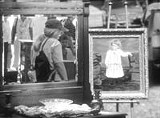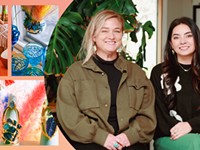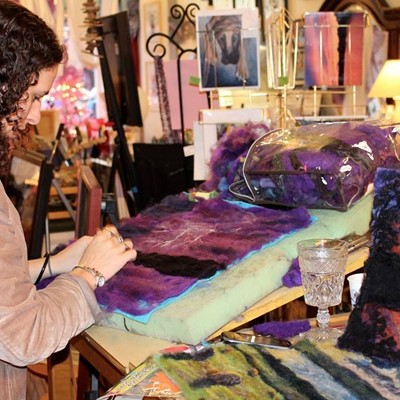[
{
"name": "500x250 Ad",
"insertPoint": "5",
"component": "15667920",
"parentWrapperClass": "",
"requiredCountToDisplay": "1"
}
]
A woman encounters a child. Encounter is an image photographically captured by Bob Gates, and one of 53 works of art included in the 60th Rochester-Finger Lakes Exhibition. Yet, what is a seemingly simple title for an equally simple action is actually a complex interplay between images and our way of seeing them. Who is encountering who, or what? So begins our segue, albeit with caution, into what Rochester's oldest juried biennial exhibition has to offer this time around.
The woman in Gates' photograph is perusing wares at an antique fair or a flea market and her image is actually her reflection caught in a bureau mirror. She's looking at something that's somewhere outside of the frame of the mirror. Meanwhile, the "child" is actually a painting on an easel that is ever so slightly positioned behind the mirror. Thus, the encounter inside the frame of the photograph is really between objects --- the mirror, the painting, the frames of both, a cut-glass bowl, a vase, and a quilt. It's a still life united within the frame.
In essence, Encounter is a series of framing devices, including the mat and frame around the photograph itself, which frames our own encounter with the image. Gates emphasizes the frame and cleverly plays with the illusionary aspect of photography. What we see in the various frames underscores what we do not see and how that which is missing creates the image.
Speaking of framing things, two years ago a group of artists rejected from that year's Rochester-Finger Lakes Exhibition came together and formed the Salon des Refusés. The goal was to provide an opportunity for rejected artists to show their work alongside (sort of) that of their winning peers. In doing so, these artists exhibited without the benefits of an established institutional "frame" that has the resources to present works of art in well-lit and well-designed spaces.
This year, the Memorial Art Gallery has once again done a really great job in showcasing the winning selections, but the Refused have no such luxury (remember, too, that even the original 19th century Salon des Refusés was government-sponsored). Their exhibition is spread across three venues --- and with one space still in the process of being turned into a "proper" exhibition space.
However, what's really interesting is how, also two years ago, the MAG's jurors seemed to employ a more clearly defined framework or juristic aesthetic such that the end result was a cohesive group show. Indeed, there were quality artworks in the Refused exhibition but at least the viewer could better understand "why this, not that."
This year's MAG exhibit, although maybe more democratic, does not concern itself with achieving, much less maintaining, a particular look. In fact, it's more sprawling. And whereas "democratic" may sound better, it's just another illusion within the frame of the museum. So, if an overall look is not the determining factor, then what is? How do you decide which quality artwork to choose over another --- especially if you're looking at slide after slide after slide?
And that brings us to another question: Why do the organizers of this year's Refusés exhibit seem to be more complacent about being rejected this year as opposed to two years ago? If anything, why is there not even more outrage? Certainly there were choices made by the jurors that are by no means clear-cut, and some are even grievous. For example, several photographs that made it in, despite competent presentation, look quite amateurish, while more sophisticated works, such as the fine Portrait of Dr. Leslie Stroebel by John Retallack or Patricia Wilder's abstract Ilfochrome print, Oracle, were left out.
And what about the fantastic mixed media collage, The Harvest, by Lynne Feldman? Fortunately, although rejected, this large acrylic and pasted fabric on canvas "tapestry" has pride-of-place on the wall in one of the alternative venues. (This rejection somehow seems particularly short-sighted seeing how Matisse: The Fabric of Dreams --- His Art and His Textiles, an exhibit which explores the artist's lifelong fascination with textiles and their impact on his art, just opened at the Metropolitan Museum of Art in New York.)
But that's exactly it, isn't it? An exhibition is only as good as the sum of its parts, which in this case, most definitely includes the jurors as well. Given that one of the jurors, Bruce Pepich, "has a good eye for high-quality contemporary craft," it should not be surprising that there are several selections of jewelry and furniture, such as the yellow gold necklace and matching earrings by Ayesha Mayadas or Myoungtaek Jung's Bending Table. Similarly, co-juror Daniel Strong does a lot of work with photography, which helps explain the high number of photographs (11) and maybe even the video.
But go. Judge for yourself.
60th Rochester-Finger Lakes Exhibition is on view at the Memorial Art Gallery, 500 University Avenue, through September 18. Hours: Wednesday and Friday 10 a.m. to 4 p.m., Thursday 10 a.m. to 9 p.m., Saturday 10 a.m. to 5 p.m., Sunday 12 to 5 p.m. 473-7720, http://mag.rochester.edu. | Salon des Refuséswill be up through July 31 at Image City Photography Gallery, 730 University Avenue. Hours: Tuesday through Friday 11:30 a.m. to 7:30 p.m. Additional venues include space at High Falls Art Gallery and Edward Jones Investments, 706 University Avenue.
Speaking of...
-
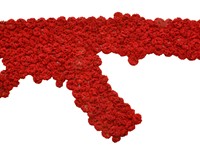
Review: "The 66th Rochester-Finger Lakes Exhibition"
Jun 18, 2019 -
Reader Feedback 8.24.05
Aug 24, 2005 -
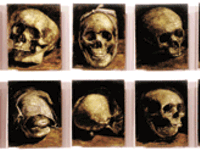
How art talks to itself
Aug 20, 2003 - More »
Latest in Art
More by Alex Miokovic
-
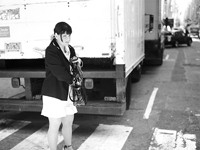
Larry Merrill at M. Early Gallery
Dec 6, 2006 -
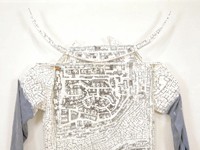
"Kim Jones: A Retrospective"
Nov 29, 2006 -
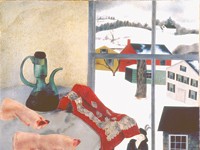
"My America" at the MAG
Nov 8, 2006 - More »
More by Heidi Nickisher
-

Larry Merrill at M. Early Gallery
Dec 6, 2006 -

"Kim Jones: A Retrospective"
Nov 29, 2006 -

"My America" at the MAG
Nov 8, 2006 - More »
